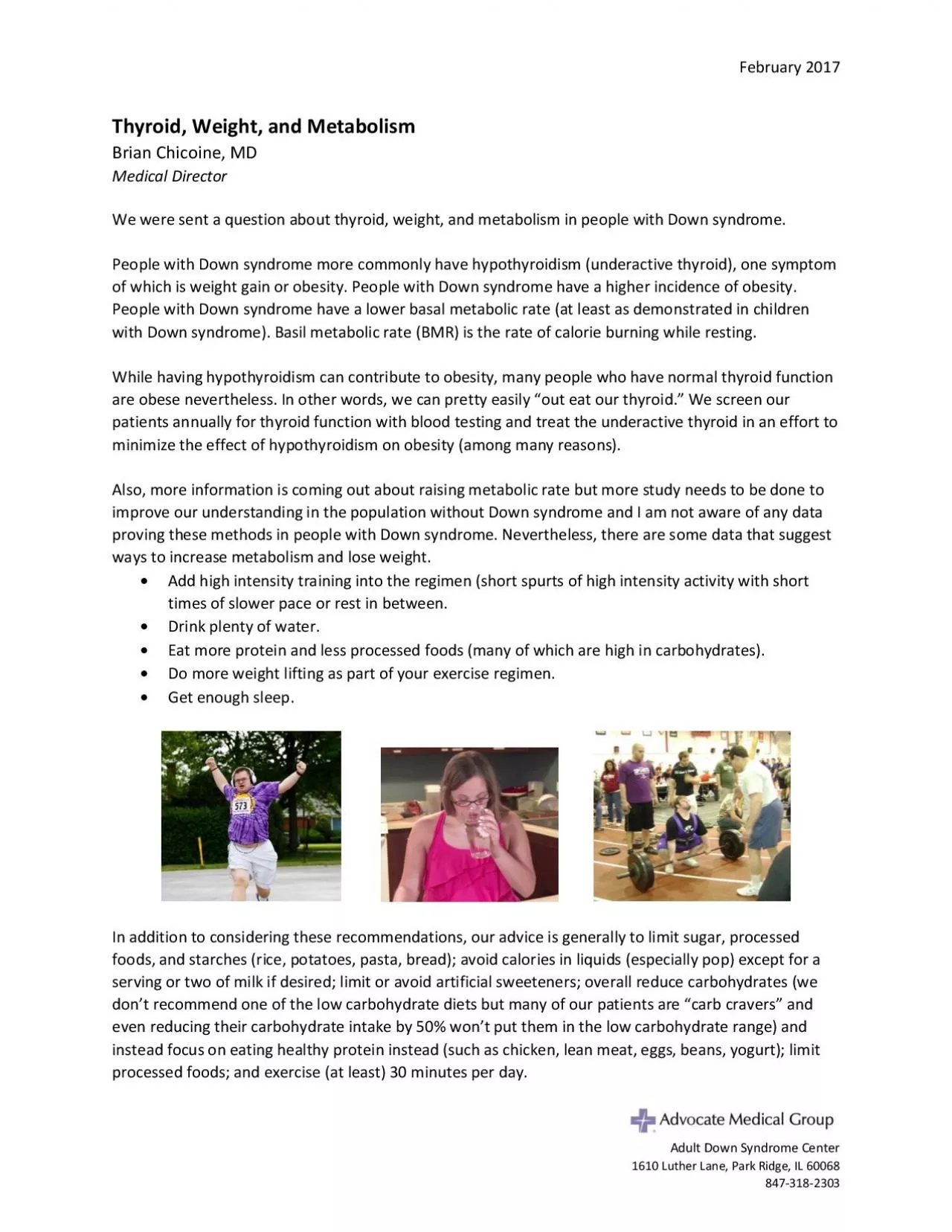

February 2017 1610 Luther Lane Park Ridge IL 60068 847 318 2303 Thyroid Weight and Metabolism Brian Chicoine MD Medical Director We were sent a question about thyroid weight and metabolism ID: 944350
Download Pdf The PPT/PDF document "Adult Down Syndrome Center" is the property of its rightful owner. Permission is granted to download and print the materials on this web site for personal, non-commercial use only, and to display it on your personal computer provided you do not modify the materials and that you retain all copyright notices contained in the materials. By downloading content from our website, you accept the terms of this agreement.
February 2017 Adult Down Syndrome Center 1610 Luther Lane, Park Ridge, IL 60068 847 - 318 - 2303 Thyroid, Weight, and Metabolism Brian Chicoine, MD Medical Director We were sent a question about thyroid, weight, and metabolism in people with Down syndrome. People with Down syndrome more commonly have hypothyroidism (underactive thyroid), one symptom of which is weight gain or obesity. People with Down syndrome have a higher incidence of obesity. People with Down syndrome have a lower basal metabolic rate (at least as demonst rated in children with Down syndrome). Basil metabolic rate (BMR) is the rate of calorie burning while resting. While having hypothyroidism can contribute to obesity, many people who have normal thyroid function are obese nevertheless. In other words, we can pretty easily “out eat our thyroid.” We screen our patients annually for thyroid function with blood testing and treat the underactive thyroid in an effort to minimize the effect of hypothyroidism on obesity (among many reasons). Also, more informat ion is coming out about raising metabolic rate but more study needs to be done to improve our understanding in the population without Down syndrome and I am not aware of any data proving these methods in people with Down syndrome. Nevertheless, there are s ome data that suggest ways to increase metabolism and lose weight. Add high intensity training into the regimen (short spurts of high intensity activity with short times of slower pace or rest in between. Drink plenty of water .
Eat more protein and less processed foods (many of which are high in carbohydrates) . Do more weight lifting as part of your exercise regimen . Get enough sleep . In addition to considering these recommendations, our advice is generally to limit sugar, processed foods, and starches (rice, potatoes, pasta, bread); avoid calories in liquids (especially pop) except for a serving or two of milk if desired; limit or avoi d artificial sweeteners; overall reduce carbohydrates (we don’t recommend one of the low carbohydrate diets but many of our patients are “carb cravers” and even reducing their carbohydrate intake by 50% won’t put them in the low carbohydrate range) and ins tead focus on eating healthy protein instead (such as chicken, lean meat, eggs, beans, yogurt); limit processed foods; and exercise (at least) 30 minutes per day. February 2017 Adult Down Syndrome Center 1610 Luther Lane, Park Ridge, IL 60068 847 - 318 - 2303 Review this information with your health care provider or dietician to make sure it is appr opriate for your circumstances. For more information on metabolism and Down syndrome, see Joan Medlen’s article on Dr. Len Leshin’s page: http://www.ds - health.com/metab.htm . Additional information about nutrition can be found on Joan’s webpage: http://www.joanmedlenrd.com . References Luke, A., Rozien, N.J., Sutton, M., Schoeller, D.A. Energy expenditure in children with Down syndrome: Correcting metabolic rate for movement. Journal of Pediatrics, 125, 1994